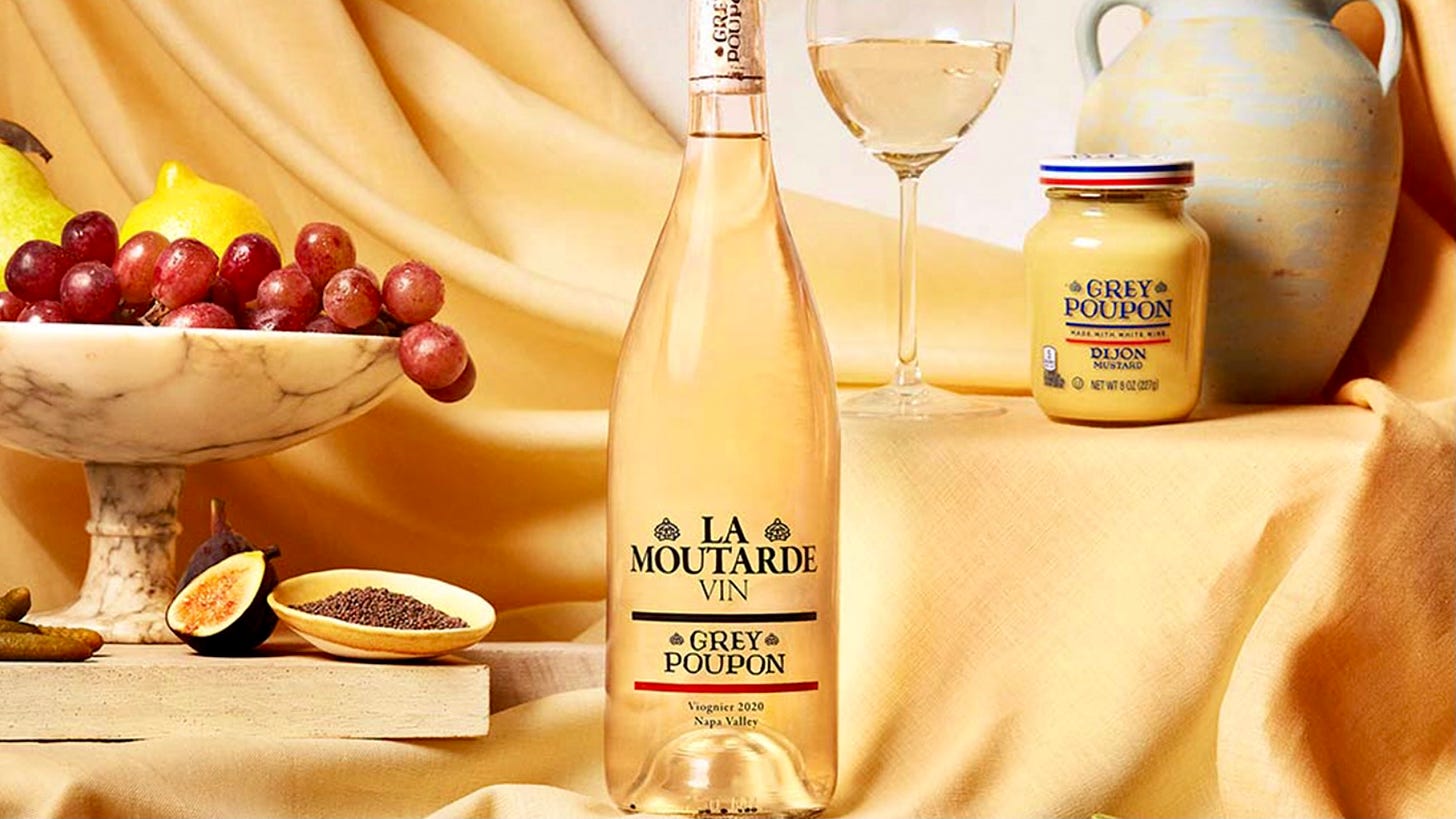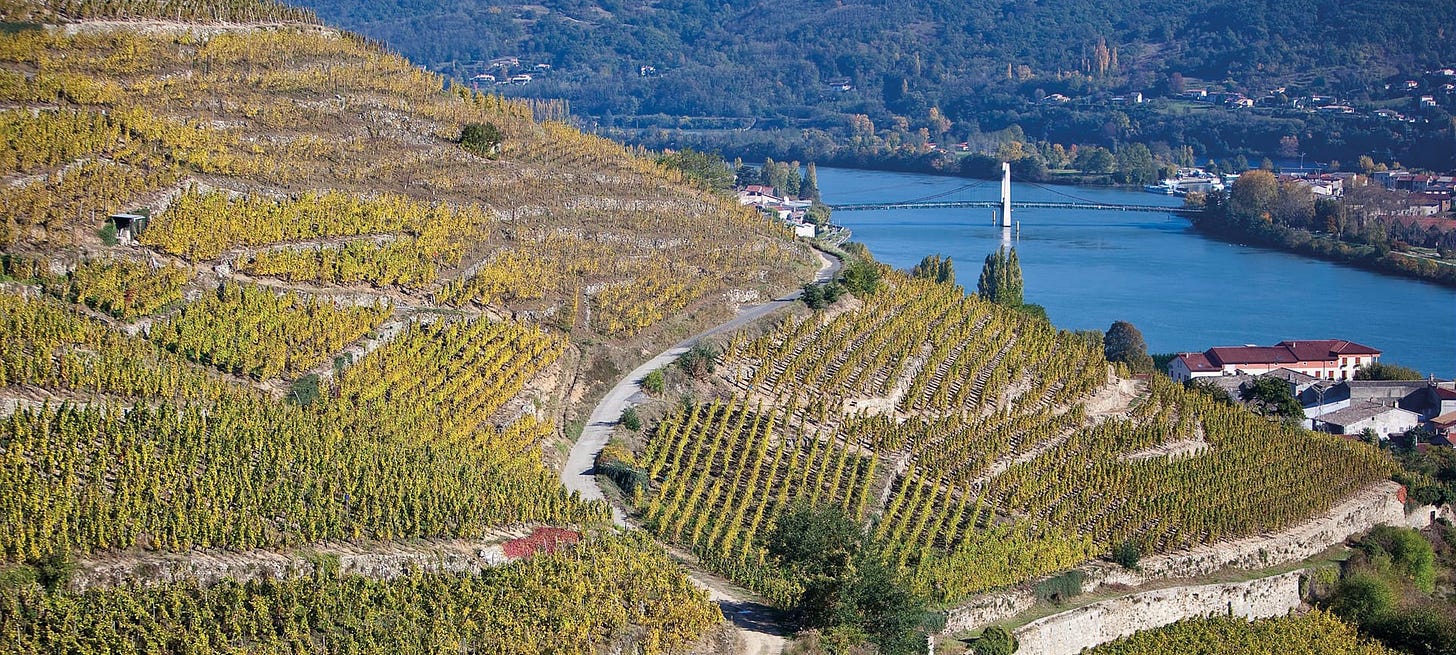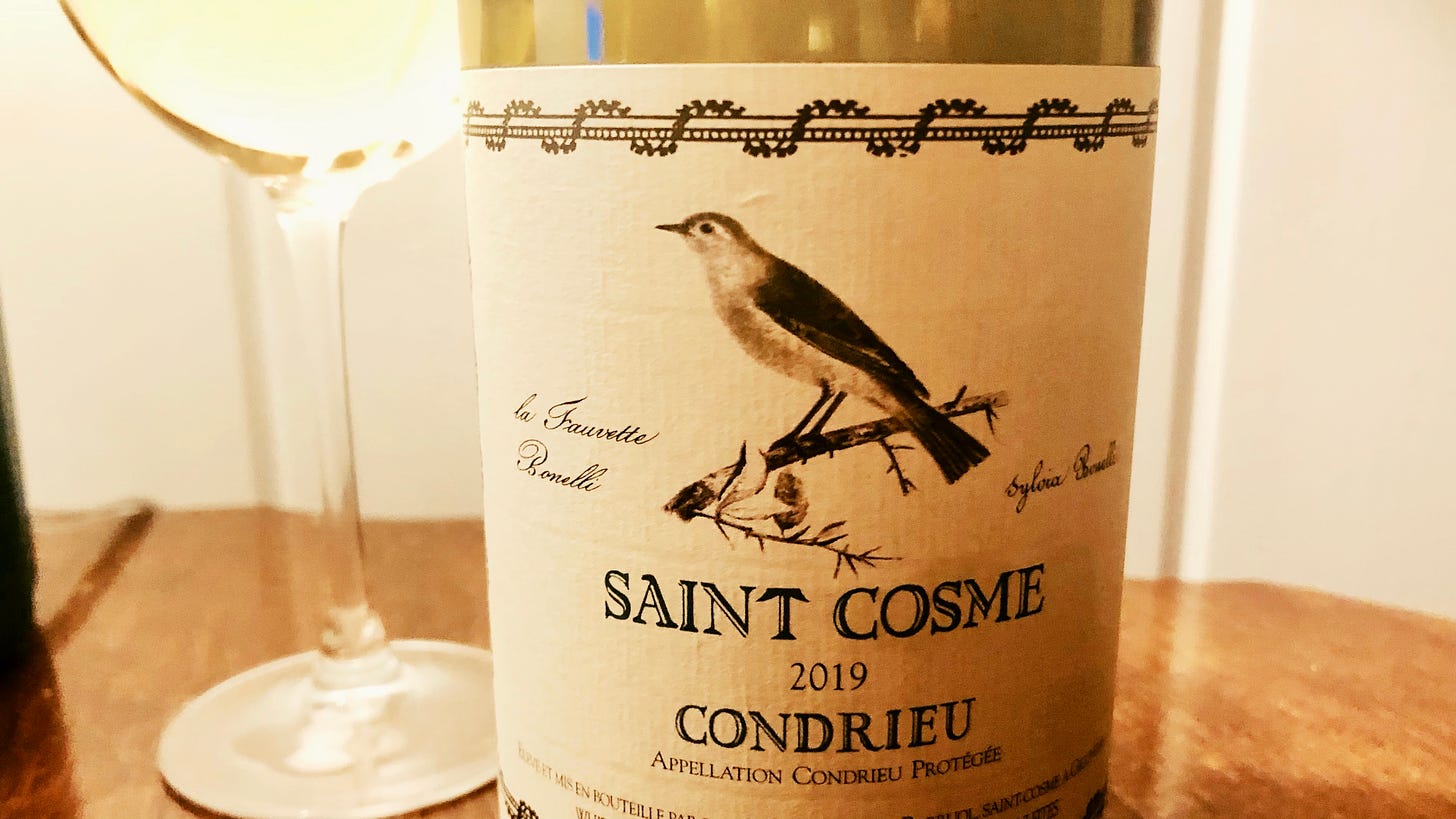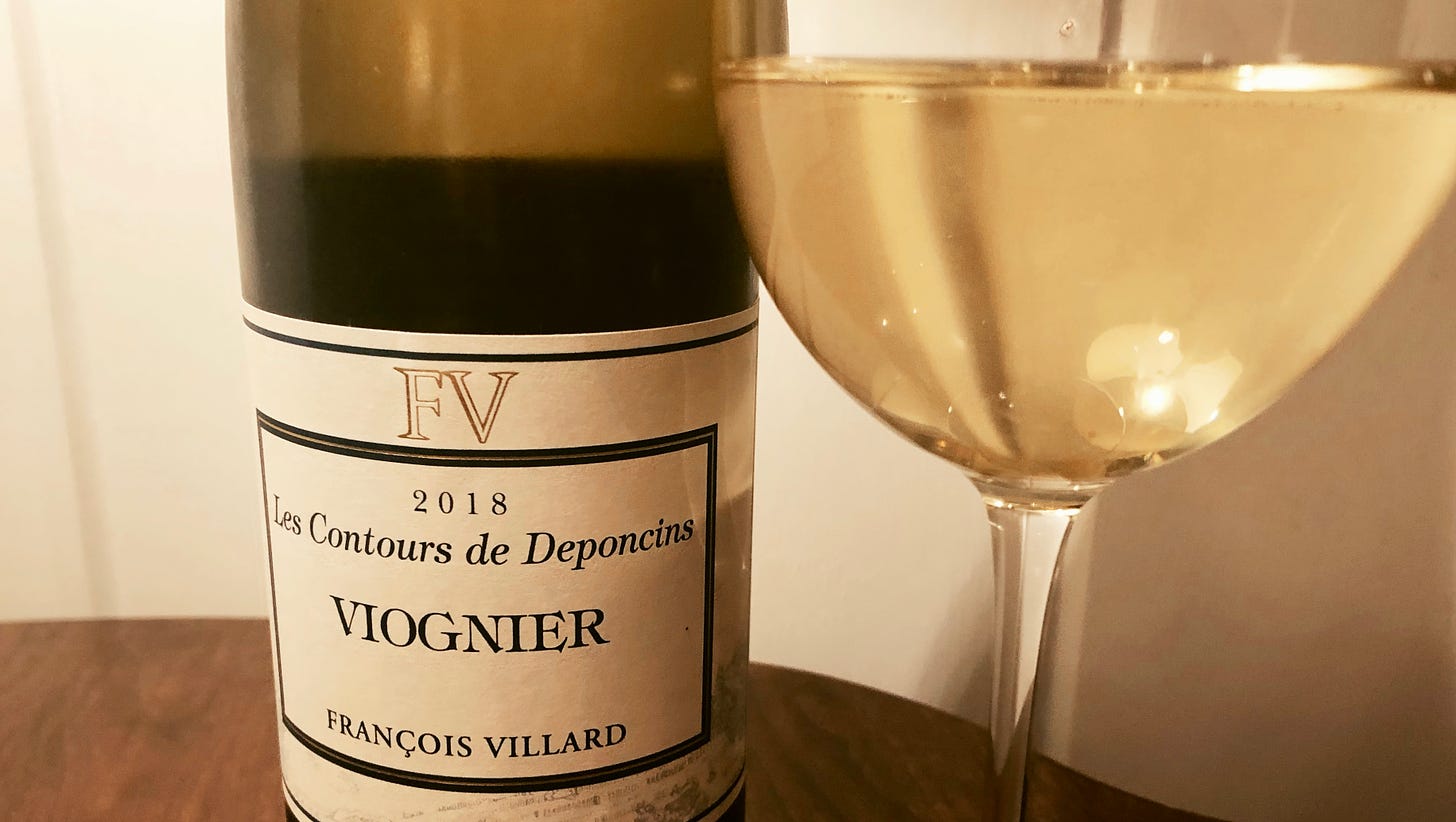Pardon Me, Would You Have Any...Viognier?
On mustard, perfumed wines, and the grape formerly known as "the next chardonnay"
A few weeks ago, Grey Poupon—America’s classiest supermarket mustard—released a wine. According to the brand (owned by Kraft Foods), La Moutarde Vin shows “bright hints of spice and pronounced citrus and floral characteristics, balanced by vibrant acidity.” Most importantly, the wine is infused with “mustard seeds to celebrate the white wine used in our iconic Dijon recipe.”
I tried my best to procure a bottle of La Moutarde Vin, dear readers. Alas, its production is very limited and I came up empty-handed. I did, however, relish the chance to ask the manager of my local wine store: “Pardon me, would you have any Grey Poupon…wine?” He looked at me like I was crazy, and said, “What the hell is that? I don’t think we’d carry anything like that.”
Perhaps the most surprising and enjoyable aspect of La Moutarde Vin is the actual wine they chose to bottle: Viognier. While the ubiquitous jars of Dijon mustard have always read “Made With White Wine,” it never crossed my mind that this wine might be viognier. Now, in my mind, viognier will be forever linked with Grey Poupon. Which isn’t as strange as one might think.
If you’re old enough, you’ll remember when viognier was supposed to be “the next chardonnay”? That’s what they told us back in the 1990s, when I was a young man first stumbling into wine. I drank quite a bit of viognier back then. You couldn’t avoid it. Now? I almost never see it on a wine list, and I don’t know a single person that says, “Boy, I’d really love me some viognier tonight.” Viognier feels like a vestige of an era when Microsoft hired Matthew Perry and Jennifer Aniston to show people how to use Windows 95.
By the 1980s, only about 80 acres of viognier existed in the entire world. By the early 2000s, this had grown to more than 10,000 acres. California alone went from 25 acres of viognier in 1982 to more than 3,000 acres in 2010. Viognier even became the signature white grape of Virginia. “Viognier truly is the flavor, and I use the word advisedly, of the year,” said British wine critic Jancis Robinson in 2005.
By the end of the aughts, it seemed preposterous that anyone believed viognier would become so popular. “Did we really believe it would be the next chardonnay?” asked wine writer Jon Bonné, in 2010. “Of all the white Rhône-native grapes, it has the greatest tendency to go off the rails.” At the same time, critic Steve Heimoff called viognier “California’s heartbreak white grape,” and noted: “Just shows you shouldn’t believe everything the wine writers say.”
Viognier is divisive. Whenever I’ve served viognier, people love it or hate it. It’s big, floral, rich, and fruity. In the essential, encyclopedic Wine Grapes, Robinson and her co-authors, describe viognier as having a “hedonistic cocktail of aromas.” Viognier is often called “perfumed” or even “cologne-like.” A friend insisted one bottle smelled like Curious by Britney Spears. She added: “I’d wear it, but I don’t want to drink it.” The other reasons for its divisiveness are the distinct note of melon, and often a lack of acidity. I happen to love cantaloupe and honeydew, but I know a surprisingly high number of people who can’t stand it. As for the low acidity, this is likely why you don’t find many long-aged examples of viognier.
The ultimate expression of viognier comes from Condrieu, in the northern Rhône. Quirky, rare, strange, and beautiful, Condrieu is notoriously difficult to describe Perhaps this is why Condrieu makes wine writers’ prose turn multiple shades of purple. They practically orgasm on the page. Jay McInerney, in his book Bacchus & Me, writes that Condrieu “lingers like the song of Keats’ nightingale.” McInerney also claims that, when you smell the aromas, “you might imagine that you’ve been dropped into the Garden of Eden, or Kubla Khan’s Xanadu as described by the opiated Coleridge.” Further, he suggests that “if orchids had a scent, this might be it.” Finally, he tells us, “Drinking Condrieu can be like stepping inside a painting by the Tahitian-period Gauguin.” Wowsers.
Perhaps it’s fitting that McInerney, the celebrated novelist-turned-wine-writer, has been one of viognier’s greatest advocates. I’ve come to see viognier as akin to second-person narration in fiction writing. The most well-known of McInerney’s novels is Bright Lights, Big City, one of the most famous second-person narratives in American literature: “You are not the kind of guy who would be at a place like this at this time of the morning. But here you are, and you cannot say that the terrain is entirely unfamiliar, although the details are fuzzy.”
When the second-person works, it is immediate and offbeat and engaging. Unfortunately, it doesn’t usually work. Like many wannabe novelists of my era, I wrote terrible second-person faux-McInerney stories in my creative writing workshops. I believe a lot of New World viognier is too often derivative and poorly executed in the same way.
For a brief moment, I considered composing this piece entirely in the second person: After you discover the Grey Poupon connection, you begin reaquainting yourself with viognier. What you find is—as much as it pains you to admit—you’ll probably have to shell out more cash than you’d like for a good one. Then I decided that was a bad idea.
Condrieu is pricey, and there’s not much of it. There’s no getting around those facts. The 2019 Saint Cosme Condrieu runs around $70, and it’s not something to stash away for years in your cellar—this is a “drink soon” purchase. But if you appreciate viognier, the Saint Cosme Condrieu is gorgeous: That perfumed nose of honeysuckle, citrus blossom, elderflower, ginger, and fennel; the rich, full-bodied palate of spiced pear, tangerine, apricot, nutmeg, alternating between pithy and creamy, with a long smokey, grilled fruit finish. (If you cannot find Saint Cosme, another great Condrieu to grab is Paul Jaboulet Ainé Domaine des Grandes Armandiers).
If $70 is just too much to spend on a bottle of viognier (and if it is, I get it), I would steer toward the 2018 François Villard Les Contours de Deponcins for around $25-$30. This is a Vin de Pays from the younger vineyards in Condrieu, but has all the classic fruity and floral notes, along with lively spice and acidity that you don’t usually find with viognier.
I’ve often been stumped on what to pair with viognier. The typical suggestions are shellfish, curry, or saffron dishes. In her book Big Macs & Burgundy, Vanessa Price suggests mac & cheese. Pairing Food & Wine For Dummies recommends…steak? So it’s all over the map when it comes to viognier.
But when I opened these bottles the other day—after reading about the Grey Poupon wine—I knew immediately what the ideal pairing ingredient would be: Dijon mustard. And I had a perfect recipe for pork chops slathered in a Dijon sauce. Mustard and viognier? But, of course.
Dijon Pork Chops
Butter
Olive oil
4 thick pork chops, bone in, seasoned with salt and pepper
Scallions, 1 bunch, chopped
Shallot, chopped
1/2 cup viognier (or other white wine)
3/4 cup bone broth or chicken stock
1/2 cup heavy cream
2 tablespoons Dijon mustard
Chopped parsley
Melt the butter into the oil in a skillet over high heat. Add chops and brown them, about 3 minutes per side. Remove chops and set aside.
Reduce to medium-high. Add shallots and scallions and cook until soft, about 1 minute. Add wine to de-glaze skillet, scraping up brown bits. Stir in broth/stock and return chops to the skillet. Bring to simmer, then cover and cook for 10-15 minutes.
Remove chops and cover in foil. Raise heat to high and reduce sauce by half, about 2-3 minutes. Add cream and continue to boil for 1-2 minutes until sauce thickens. Remove from heat, and stir in mustard and parsley. Slather the sauce on the chops and serve.





